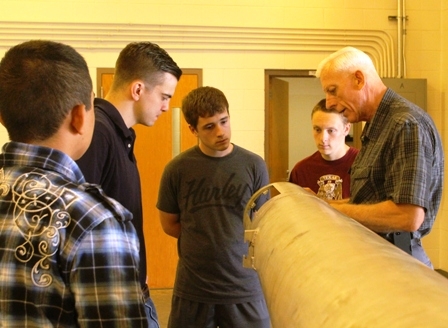The sky's the limit

MFHS aerospace engineering teacher Randy Guffey (far right) and Swagelok Austin representative Grant Bollinger advise MFHS students Eric Avalos, Tyler Taber and Marshall Jett as they work on their rocket Wednesday, April 22.
By Emily Hilley-Sierzchula
It’s not every day teenagers design a rocket designed to sail through the atmosphere at more than twice the speed of sound. Nor is it commonplace for high school students to have their work critiqued by National Aeronautics and Space Administration (NASA) engineers.
Marble Falls High School (MFHS) aerospace engineering students are working with the “best of the best” in aeronautics to build a high-altitude test rocket as part of a NASA moon rock project.
Students have been committed to the project since October, 2014, when the planning phase began.
“They’re taking on a big project that requires a lot of time and energy,” said Randy Guffey, MFHS aerospace engineering teacher. Most of his students are seniors who will put high school in the rear view mirror next month, except for their rocket project that will keep them committed for the summer season. “They’re giving up part of their summer to work on it,” Guffey said.
The 20-foot rocket is scheduled to be launched in July at the U.S. Army’s White Sands Missile Range in New Mexico. Aiming for a ceiling of 100,000 feet before the nose cone breaks off to release the payload, the rocket will be capable of reaching its top velocity of 1,800 mph. (Mach 2.4) in less than 30 seconds, Guffey said.
The payload, a canister of simulated moon rocks, will hit the ground at around 200 miles per hour.
Ensuring moon rocks don’t become moon dust when hitting Earth’s surface if a parachute fails is the problem students are helping solve.
For the full story, see Friday's Highlander.

